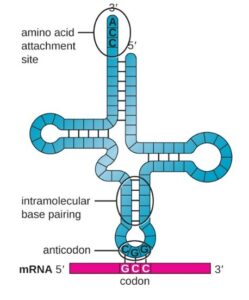Chapter 8: DNA Replication and Protein Synthesis
8.2. Protein Synthesis
Learning Objectives
By the end of this section, you will be able to:
- Explain how the genetic code stored within DNA determines the protein that will form.
- Describe the process of transcription.
- Describe the process of translation.
- Describe the roles of mRNA, tRNA and rRNA in protein synthesis.
- Describe the function of ribosomes.
- Explain the importance of the genetic triplet code.
Protein synthesis
- The process occurs in two different cell locations (Figure 8.2.1.)
- Transcription occurs in the cell nucleus where mRNA is synthesized from a DNA template. After undergoing modification, mRNA moves outside the nucleus for translation.
- Translation occur in the cytosol on ribosomes where mRNA’s coded information is translated to the correct amino acid sequence for the new protein.
- A common strategy throughout protein synthesis is complementary base pairing.
Transcription: DNA to mRNA
DNA contains the genes. A gene is the functional segment of DNA (a nitrogenous base sequence) that specifies the order in which amino acids are to be placed in the peptide (or polypeptide) chain being synthesized. Activation of this DNA segment is called gene expression and transforms the information coded in a gene to a final gene product. Gene expression ultimately dictates the structure and function of a cell by determining which proteins are made.
In transcription, one DNA strand serves as the template for the synthesis of mRNA with base pairs that complement those of DNA (Figure 8.2.2.). mRNA carries the genetic code for a protein’s amino acids as units of three nitrogenous bases. These are called the mRNA codons. For example, if TAC (Thymine-Adenine-Cytosine) is the nitrogenous base sequence on a segment of the DNA template, the mRNA codon will have AUG (Adenine-Uracil-Guanine). The newly synthesized mRNA strand undergoes post-transcriptional modification and the resulting so-called mature mRNA leaves the nucleus destined for the ribosome. The mature mRNA is a single linear strand of nucleotides which bases complementary to those of the DNA gene.
Translation: mRNA to Protein
Translation occurs outside the nucleus on a ribosome which is organized in large and small subunits (Figure 8.2.3.). mRNA binds to the ribosomal small subunit and tRNA binds to its large subunit. Ribosomes are found either free in the cytosol or attached to an organelle called the endoplasmic reticulum (discussed in a later chapter).
Translation requires mRNA, ribosomal RNA (rRNA) and transfer RNA (tRNA).
A ribosome is a macromolecule composed of many polypeptides and ribosomal RNA (rRNA). rRNA is a specialized enzyme-like catalyst called a ribozyme which functions to catalyze the formation the peptide bonds between amino acids during polypeptide formation. Ribosomes (rRNA) are synthesized in a specialized region of the cell nucleus called the nucleolus and then transported out to exist either free in the cytosol or attached to certain cell organelles. (Details of cell organization is discussed in a later chapter.)
The tRNA molecule has a clover-leaf shape and two binding sites (Figure 8.2.4.). One end of the tRNA carries an amino acid and the other end contains a triplet nucleotide sequence (the anticodon). Twenty amino acids are involved in making proteins and each amino acid has its own carrier tRNA carrier.

License and attributions:
- Anatomy and Physiology, Second edition, 2022, Betts, J.G. et al. License: CC BY 4.0. Located at https://openstax.org/books/anatomy-and-physiology-2e/pages/3-4-protein-synthesis
- Concepts of Biology, 2013, Fowler, S. et al. License: CC BY 4.0. Located at https://openstax.org/books/concepts-biology/pages/9-4-translation
- Microbiology, 2016, Parker, N. et al. License: CC BY 4.0. Located at https://openstax.org/books/microbiology/pages/11-4-protein-synthesis-translation
- Biology, Second edition, 2018, Clark, M.A. et al. License: CC BY 4.0. Located at https://openstax.org/books/biology-2e/pages/4-3-eukaryotic-cells
